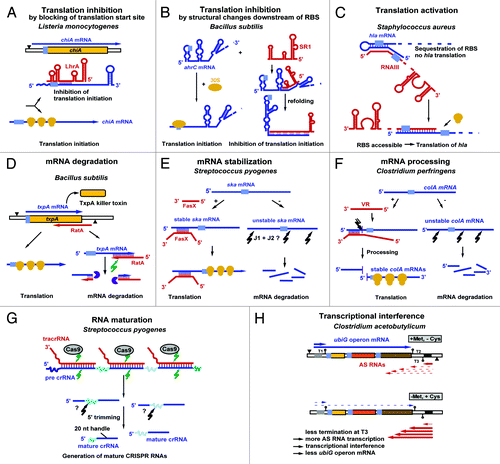Figures & data
Table 1. Systematic searches for sRNAs in low GC Gram-positive bacteria
Figure 1. Mechanisms employed by sRNAs encoded from low-GC Gram-positive bacteria. All currently known mechanisms for sRNAs encoded from chromosomes are summarized. For additional mechanisms employed by plasmid-encoded sRNAs, see reference Citation13. Antisense RNAs are drawn in red, sense RNAs in blue. Black triangles denote promoters. Light blue, ribosome binding sites (RBS). Yellow symbols indicate ribosomes. Green arrows denote RNase III cleavage; black arrows indicate unknown RNase action. The violet symbol represents RNase R. For details, see text. B, C, E, F, and H are based on reference Citation13.

Table 2. Overview of cis-encoded sRNAs from low-GC Gram-positive bacteria
Table 3. Overview of trans-encoded antisense RNAs from low GC Gram-positive bacteria
Figure 2. SR1 and SR4, a trans- and a cis-encoded sRNA from B. subtilis. As in , the antisense RNAs are indicated in red, the sense RNAs in blue, RBS in light blue, ribosomes are in yellow, RNase III in green, and RNase R in violet. (A) SR1, a trans-encoded sRNA, is the first identified dual-function sRNA from B. subtilis. +, activation; -, repression. CcpA and CcpN repress sr1 transcription under glycolytic conditions. TF is a novel transcription factor that activates sr1 transcription at cold-shock. (B) SR4, a cis-encoded sRNA, is the antitoxin of the type I TA system bsrG/SR4. It is the first antitoxin for which two independent functions have been found. For details, see text.

